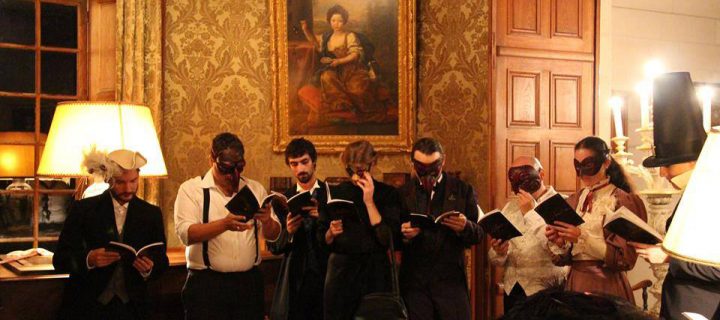We like to engage in larp through compelling and vivid characters. However, the available tools to create them are many and diverse: whether we go with short or detailed characters, give them a lot of background or just create a short frame for the players to develop, whether we leave the control of the story to the larpwright or give more leeway towards the player’s agenda. All of these approaches are tools that can be calibrated according to each designer’s purposes.
France has in the past fifteen years enjoyed the development of its specific, character based, drama-oriented larp scene called the romanesque genre. With a heavy emphasis on character development and personal relationships, this type of game has garnered a huge, devoted following. Though it has been but recently documented (Choupaut, 2013; Algayres, 2016a), the romanesque scene has steadily evolved through almost two decades and developed some specific traits regarding game design.
This article will endeavour to present the romanesque style larp in relation to other similar larp styles in Europe, and establish some tools we use to create characters and narration in this type of larps. The objectives are to expand both the knowledge about larp production in Europe and the narrator’s toolbox to create characters.
What Is the French Style Romanesque Genre?
An Overview of the Genre
The romanesque term started being applied to games in 2010, by Frédéric Barnabé for l’Agonie du Poète (2010). However, that game was the last iteration of a long series of games coined as “emotional” or “dramatic,” which was almost as old as the practice of larp in the country. In its primary sense, romanesque means “which belongs to the realm of a novel,” a descriptive for dramatic events or actions. Therefore, it is used to describe games that are constructed as rich, narrative experiences, with pre-written characters whose rich backstory and psychology are the driving forces of the larp.
Since then, the term has been appropriated to qualify many games following the same general features. While these features might still be debated, we have focused on the following traits (Algayres, 2016a):
- Focus on the character. Character creation is mostly in the hands of the organisers, and they will be very detailed, with a lot of intertwining backstory and built-in information.
- A huge impact of the past which explains the details in the character. The backstory gets a significant importance in building the potential for narration and the character’s psyche. Some elements might be kept secret, to be discovered for dramatic impact.
- An environment built as a microcosm. The diversity of characters serves as a means to establish the workings of society in the specific time and context of the game, which is why the romanesque usually love historically inspired settings.
- The use of narrative archetypes. Romanesque larps often draw inspiration from literary classics and embrace the romanesque genre’s common tropes as a means to drive narration.
- The dominance of tragedy, with character-based narrative integrating a lot of human drama, conflicts and character dilemma. This is not an absolute, though, some games advocate a lighter atmosphere or tragedy-comedy mix, such as Rêves d’Absinthe (Algayres and D’authie, 2011), or Prima La Musica (Primoot, 2016).
- Tightly-knit narrative arcs, which are meant to reach their climax during the game, with characters living out an exceptional destiny or a defining moment of their lives over the course of the game.
- A focus on the characters’ emotions and on each participant’s identification with their character, in the same manner as a reader identifies with a character in a work of fiction. Bleed may occur as a result of identification with the character.
The generally recognised strength of these larps is that they provide a very rich, detailed frame, with complex characters thoroughly inserted in their context and network of relationships. However, as a significant part of the world, character-building and control of the story remains in the hands of the organisers. This type of larp places greater limitations on players’ agenda and freedom (in character selection and creation especially). This is usually a design choice that creators justify by that they are using it to enrich the overall story and narrative, to create more closely connected characters and potential for tight narratives and complex story arcs.
The Historically Inspired Larp in France and in Europe
While the term romanesque has been coined to describe a very specific sub-genre of French larp culture, we can observe games with similar intent in several other European countries. It is also interesting to see that we can find similar traits in the games in the historically inspired genre. History and larp have always worked well together, since “a historical larp can have a more interesting and challenging gameplay because of the richly faceted social situations history brings with it” (Salomonsen, 2003, p. 94). Game designers from all over Europe have had the opportunity to exploit the richness of history all the while retaining the creative licence to twist accuracy for practical or dramatic purposes, and we’ll quote some significant, but by no means exhaustive, examples.
In Finland, historically-inspired larps are a part of the scene, with Viking history, the Victorian era, and Finnish history around the time of independence featured as time periods of interest. Finland, like France and for similar reasons, has had a tradition of long, very detailed characters, as the absence of workshops made it necessary to include a lot of information about the character’s psyche and environment in written form.
An interesting example is provided by the Czech larp Skoro Rassvet (Haladová, Platir et al., 2013).[1]Whose international runs were organised in Denmark through the organisation Solhverv. Skoro Rassvet is a game set in 19th century Russia, heavily influenced by Russian literature and especially Tolstoy. The game is played in a day, with a half day of workshops, and the action takes place during a family gathering for a formal dinner. In its approach and objectives, this game would certainly have been dubbed romanesque in France. The character design, however, differed sensibly. The written material was relatively short by historical larp standards (less than half a dozen pages), and most of the character development was done during the workshops, essentially through social codes and rituals, and role-playing scenes from the past (Hampejs, 2015).
Other examples from the obviously rich Czech scene include Salon Moravia (Bondy and Bondyová et al., 2104), set in a brothel during World War II, De la Bête (Pešta and Wagner et al., 2013), a super-production set in 18th century France, and Legion (Pešta and Wagner, 2015), which combines historical inspiration and hardcore larp in its depiction of a 1915 retreating military unit.
Norway also has a significant historical larp scene, which used to be dubbed “stocking larps” (Stark, 2013). Norwegian historical larps were presented at the French convention Les GNiales with great interest (Hansen, 2014). They appeared as very rich, deeply layered productions, with high requirements for historical and costume accuracy which put them close to historical reenactment, and, in keeping with Nordic larp, bigger creative agenda for the players where the building of interactions and narrative arcs were concerned. Kjærlighet uten strømper [Love without Stockings] (Voje and Stamnestrø et al., 2004) can be mentioned as an example of the historical drama inspiration. The game, set during a wedding in 1771, presents its objective as a mix of intrigue, personal and societal drama, integrating significant amounts of conflict and romance.
The rapidly blooming progressive scene in Italy, under the banner of the collective Terre Spezzate, has made several contributions to the historically inspired genre. I Ribelli della montagna [Rebels on the Mountain] (Capone and Bi , 2015) was a rich, vivid rendition of the last months of World War Two which got unprecedented media attention, support from A.N.P.I.—Associazione Nazionale Partigiani Italiani [National Association of Italian Partisans], and praise for its thoughtful and sensitive rendition of the conflict. Chiave di Volta [Keystone] (Tireabasso and Villa Avogadro, 2015), is a lush dramatisation of the 19th century centred around the theme of power, the possibility to play both masters and servants in a complicated power play, and a huge production value. Both of these productions have cleverly integrated design elements and techniques from Nordic larp (safety mechanics, workshops etc.) while retaining their own unique style, resulting in extremely well crafted larps.
And of course, the blockbuster larp also ventured into the historical drama setting with Fairweather Manor (Boruta, Raasted and Nielsen et al., 2015), a larp set in Edwardian England and inspired by the hit TV-show Downton Abbey. While the brute force design proved partially unfit to cover the complexity of a multi-layered society (including diversity of age, rank and function), the game was effective in carrying over a lot of content and player-generated interactions. The first iteration of the larp warranted an unofficial spinoff, a second run and a sequel over the course of the following year.
Back in France, the most recent larps of the romanesque genre have shown a clear ambition to expand on the genre and make it evolve for the better through the inclusion of those nordic style techniques whose use has become widespread in recent years (workshops, black box), keener focus on directing themes, and more refined work on the societal frame. Prima la Musica (Primoot, 2016) is a larp about the French opera scene of the 19th century, using opera-inspired dramatics and music both diegetically and non-diegetically through an open, black box system. Still Water Runs Deep (Ruhja, 2014) is a Jane Austen/Dickensian inspired larp with a sharp focus on class hierarchies and gender stereotypes, which was also played as a cross-gender experience, with participants praising the insight it gave them of the opposite genders’ constraints and problematics. Finally, Harem Son Saat (Algayres, 2016b) was the first international game of the genre, using English as a main language,[2]Which stood for Turkish in the 1913 Ottoman background, while French was in-game a diplomatic second language. built around the themes of oppression, gender segregation and culture shock.
Therefore, while romanesque is solidly a French term, character-driven literary and historically inspired larps have by no means been limited to a single geographic area. The rich potential of history and its dramatisation has been widely exploited and feels still rich with great potential.
Character Design and Narrations in the Romanesque Genre
Archetypes in the Romanesque Genre
Romanesque larps are character-centred games, with a significant part of the game design being devoted to the conception of the characters, all of them organiser-created. While length and composition of characters tend to vary from one larpwright to another, a couple of techniques can be pinpointed.
The first one is what I’d like to call the smart use of archetypes. This is a very thin line to tread, as any overused archetype can become a cliché and damage the necessary suspension of disbelief. Let’s use an example. You might hear French players harp about the “switched at birth” plot, used as an ironic commentary on romanesque clichés, though, to my knowledge, it has rarely been used in the scene, except in the prohibition-game era Chicago. Illegitimate children and foundlings, however, are definitely a staple of the genre, but this is fitting to historical periods when children born out of wedlock had no status in society.
Classic or archetypal plotlines or characters can be true to period, but also resonate with an audience of participants which has usually grown up learning and enjoying these stories. It has been argued that larp itself can be viewed as an incarnation of the monomyth, each participant’s experience echoing the traditional hero’s journey. (Hook, 2010, p.34)
So how do we go about practicing the clever use of archetypes? In a romanesque setting, we consider all characters protagonists. Therefore, we’ll use archetypes to define them through several angles:
- The inner nature of the character: the patriarch, the overbearing matron, the hotheaded, the cynic, the ingénue, the rebel. This is very basic and can turn cliché if the character is limited to the inner archetype.
- Their contrast in relation to others (also called foil). This is particularly frequent in pairs or trios of characters, such as siblings, close friends, etc. You’ll have the optimist to the realist, the extrovert to the introvert, the by-the-rules personality against the rebellious type, etc. Foils are really useful because, through simple characterisation, they create a lot of potential for conflict between the characters.
- Their position within a network of relationships and in relation to others. Each character is the participant’s protagonist, but can be another’s sibling, a third’s best friend, the romantic interest of a fourth, the antagonist to a fifth and so on.
If we just use any archetype, a character stands a sure chance to become cliché, because its archetype will be instantly identifiable, and its characterisation weak. This is where several archetypes used in conjunction with the others become useful: the character becomes more layered, therefore more human. However, the archetypes at work can still have a universal meaning to participants, which makes them particularly effective.
The Dual Approach in Character Design
Another element of character design typical to the romanesque genre is what we call the dual approach. While it is by no means limited to the romanesque, it has also become typical of some of the games. The dual approach in character design is a combination of the following elements:
- The initial approach: the character’s motif or raison d’être, their reason for being present. This can be accomplished through family ties, a function or specific job, a plot-related motif. This must answer the questions: why are they here? Why should they care? Why will they stay?
- The final approach: what will the character’s potential arc be? What will be their greatest moment? It can be a reveal (hence the predominance of secrets in some larps), an epiphany, a staged grand scene, a necessary evolution, but an element (or several) which will make the character’s journey (and the participant’s experience) significant and meaningful.
In a typical design, both of these approaches, as well as the archetypes at play, are handled simultaneously, as the character (and the network of characters) is constructed bit by bit. The final criteria is to analyse if the characters are playable, interesting, and enjoyable.
The objective of this type of design is to provide the participant with potential for a rich story and interactions. Some games tend to follow a more streamlined route, and have even been criticised for railroading the character’s arc too much. However, most of these games definitely have a clear narrativist approach, only limited to what is coherent with the character’s context and psyche. For some time periods in history, these elements of context and the social pressure can really be played as antagonists of their own.
Conclusion
With more than ten years of established existence and a very rich history of diverse and celebrated games, the French style romanesque scene is certainly a prime example of a national scene which strives through its own specific identity, all the while getting enriched through contact with other genres and countries.

Rêves d’Absinthe (post-game, Joram Epis).
Bibliography
- Algayres, Muriel, Le GN Romanesque, Electro-GN. 2016a [date of access 29/08-2016] http://www.electro-gn.com/10332-le-gn-romanesque
- Barnabé, Frédéric. De différentes approches de la conception d’un scenario [Different approaches of larp scenario building], first published 2004, to be republished 2017 https://www.electro-gn.com/10932-approches-de-la-conception-dunscenario
- Choupaut, Vincent. The Frenchstyle Romanesque Larp, In Electro-larp. 2013 [date of access 29/082016] http://www.electro-larp.com/275-thefrenchstyle-romanesque-larp
- Hampejs, Tomáš. Skoro Rassvet — Vodka, tears and Dostoyevsky. In The Nordic Larp Yearbook 2014. Edited by Charles Bo Nielsen and Claus Raasted. Copenhagen, Denmark: Rollespilsakademiet, 2015.
- Hook, Nathan. Larp of a Thousand Faces. In Playing Reality. Edited by Elge Larsson. Stockholm, Sweden: Interacting Arts, 2010.
- Salomonsen, Xenia. The use of History in larp. In As Larp grows up—Theory and Methods in Larp. Edited by Morten Gade, Line Thorup and Mikkel Sander. Fredericksberg, Denmark: Projektgruppen KP03, 2003.
- Stark, Lizzie, Larp culture in Norway, In Leaving Mundania: Inside the World of Larp, 2013. [date of access 15/09-2016] http://leavingmundania.com/2013/04/25/larp-culture-in-norway/
- Tirabasso, Chiara. Chiave Di Volta: The Devil is in the detail. In The Nordic Larp Yearbook 2015. Edited by Charles Bo Nielsen, Claus Raasted and Erik Sonne Georg. Copenhagen, Denmark: Rollespilsakademiet, 2016.
Personal Communication
- Erlend Eidsem Hansen. Days of deeds, Nights of Myth— The Design tricks of Historic Larps in Norway. Les GNiales. Paris, France: Conference, 2014.
Ludography
- Algayres, Muriel and Abbaye d’Authie. Rêves d’Absinthe [Dreams of Absinth]. Ouroux, France: Association Rôle, 2011.
- Algayres, Muriel. Harem Son Saat. Château de Cernay, France: Association Rôle, 2016b. http://www.assorole.fr/haremlarp-en/
- Barnabé, Frederick. L’Agonie du Poète [The Poet’s Agony]. Joyeuse Castle, France: Association Rôle, 2010. http://agoniedupoete.fr/
- Bondy, Radim, Veronika Bondyová, Jan Fiala, et. al. Salon Moravia. Brno, Czech Republic, 2014. http://www.pojd.name/salon/
- Boruta, Szymon, Charles Bo Nielsen and Claus Raasted et. al. Fairweather Manor. Mozna, Poland: Dziobak Studios, Rollespilsfabrikken (DK) and Liveform (PL), 2015. http://www.fmlarp.com/
- Capone, Andrea and Elio Bi . I Ribelli della montagna [Rebels on the mountain]. Villaggio delle Stelle, Italy: Terre Spezzate, 2015. http://www.grv.it/setteprincipati/item/424-home-ribelli.html
- Haladová, Markéta, Petr Platil, Martin Buchtík, et. al. Skoro Rassvet [Breaking Dawn]. Translated by Jeppe Bergmann Hamming, Maria Bergmann Hamming. Odense, Danmark: Association Solhverv, 2103. http://rassvet.cz/
- Pešta, Adam and David František Wagner et al. De la Bête. Valeč Castle, Czech Republic, 2013. http://www.delabete.cz
- Pešta, Adam and David František Wagner et al. Legion : Siberian Story. Hvožďany, Czech Republic: Association Rolling, 2015. http://legion.rolling.cz/
- Primoot Team. Prima la Musica ou L’Opéra Terrible [Prima la Musica or the Opera Terrible]. Montbraye Castle, France: Association Urbicande Libérée, 2016.
- Ruhja Team. Still Water Runs Deep. Paris, France: Association Rôle, 2014.
- Tirabasso, Chiara and Daniele Cristina Villa Avogadro. Chiave di Volta [Keystone], Biella, Italy: Terre Spezzate, 2015 http://www.grv.it/chiave
- Voje, Adrian Angelico and Anne Marie Stamnestrø et al. Kjærlighet uten strømper [Love without stockings]. Kleve gård, Norway: 2004. http://www.rollespill.no/rokokko/
This article was initially published in Once Upon a Nordic Larp… Twenty Years of Playing Stories published as a journal for Knutepunkt 2017 and edited by Martine Svanevik, Linn Carin Andreassen, Simon Brind, Elin Nilsen, and Grethe Sofie Bulterud Strand.
Cover photo: L’Agonie du Poete (play, Nadine). Other photos by Joram Epis.









